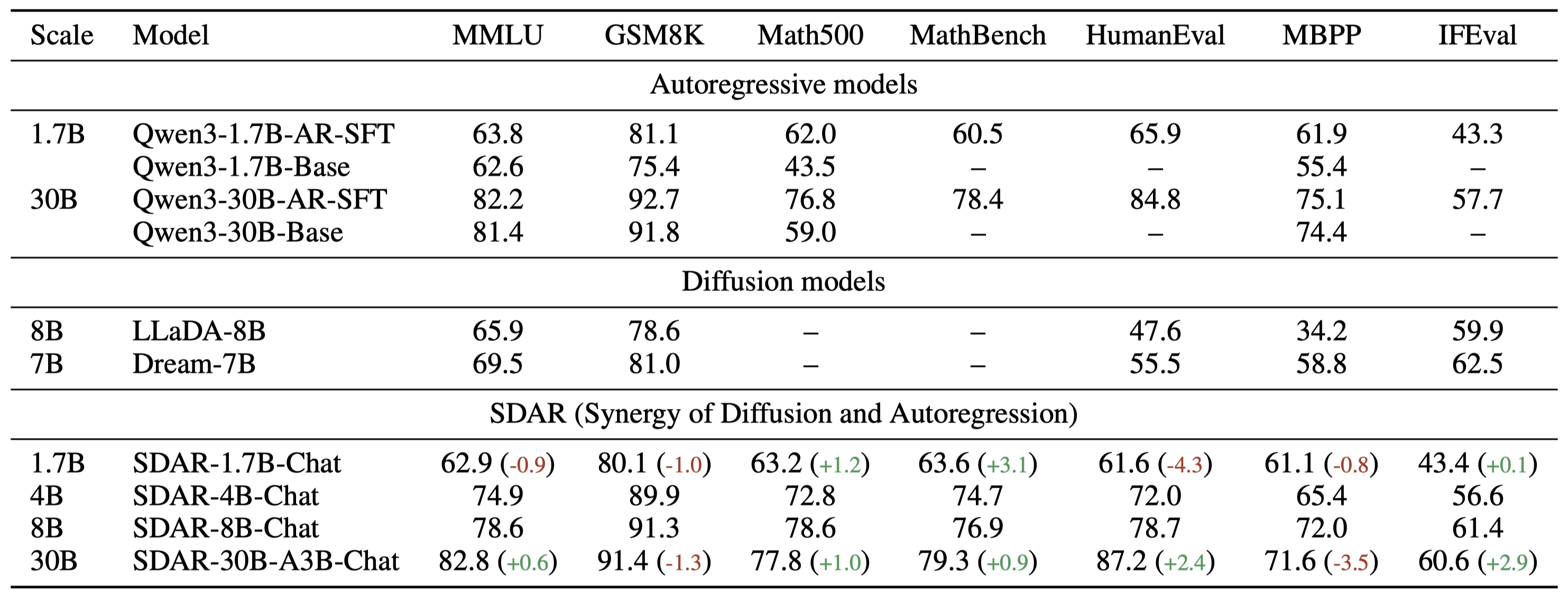---
license: apache-2.0
library_name: transformers
---
# SDAR

[Arxiv](https://arxiv.org/abs/2510.06303) • [💻Github Repo](https://github.com/JetAstra/SDAR) • [🤗Model Collections](https://huggingface.co/collections/JetLM/sdar-689b1b6d392a4eeb2664f8ff)
# Introduction
**SDAR** (**S**ynergy of **D**iffusion and **A**uto**R**egression) model is a new large language model that integrates autoregressive (AR) and discrete diffusion modeling strategies. It combines the efficient training paradigm of AR models with the highly parallel inference capability of diffusion models, while delivering performance fully on par with SOTA open-source AR models. At the same time, SDAR sets a new benchmark as the most powerful diffusion language model to date. We highlight three major conclusions from our study:
> [!IMPORTANT]
> Take-home message
>
> - **Balanced Efficiency:** SDAR unifies the **efficient training** of AR models with the **parallel inference** of diffusion, achieving both fast training and inference.
> - **Fair Comparisons:** In rigorously controlled experiments, SDAR achieves **on-par general task performance** with strong AR baselines, ensuring credibility and reproducibility.
> - **Superior Learning Efficiency:** On complex scientific reasoning tasks (e.g., GPQA, ChemBench, Physics), SDAR shows **clear gains over AR models** of the same scale, approaching or even exceeding leading closed-source systems.
# Inference
## Using the tailored inference engine [JetEngine](https://github.com/Labman42/JetEngine)
JetEngine enables more efficient inference compared to the built-in implementation.
```bash
git clone https://github.com/Labman42/JetEngine.git
cd JetEngine
pip install .
```
The following example shows how to quickly load a model with JetEngine and run a prompt end-to-end.
```python
import os
from jetengine import LLM, SamplingParams
from transformers import AutoTokenizer
model_path = os.path.expanduser("/path/to/your/sdar-model")
tokenizer = AutoTokenizer.from_pretrained(model_path, trust_remote_code=True)
# Initialize the LLM
llm = LLM(
model_path,
enforce_eager=True,
tensor_parallel_size=1,
mask_token_id=151669, # Optional: only needed for masked/diffusion models
block_length=4
)
# Set sampling/generation parameters
sampling_params = SamplingParams(
temperature=1.0,
topk=0,
topp=1.0,
max_tokens=256,
remasking_strategy="low_confidence_dynamic",
block_length=4,
denoising_steps=4,
dynamic_threshold=0.9
)
# Prepare a simple chat-style prompt
prompt = tokenizer.apply_chat_template(
[{"role": "user", "content": "Explain what reinforcement learning is in simple terms."}],
tokenize=False,
add_generation_prompt=True
)
# Generate text
outputs = llm.generate_streaming([prompt], sampling_params)
```
# Performance
### SDAR v.s. Qwen
For **SDAR** models, inference hyperparameters are set to: `block_length = 4`, `denoising_steps = 4`, greedy decoding.
For **Qwen3-1.7B-AR-SFT** and **Qwen3-30B-AR-SFT**, we use *greedy decoding*, and the base models **Qwen3-1.7B-Base** and **Qwen3-30B-Base** are derived from the [Qwen3 Technical Report](https://arxiv.org/abs/2505.09388).

### SDAR-Sci v.s. AR Baseline
This table presents a **controlled comparison** between AR and SDAR under the same backbone and dataset settings.
The results are averaged over 8 runs for GPQA, and over 32 runs each for AIME 2024, AIME 2025, and LiveMathBench.

#### SDAR-Sci v.s. Other Models
This table positions **SDAR-30B-A3B-Sci(sample)** against leading open-source and closed-source LLMs.
Scores for external models are sourced from the [InternLM/Intern-S1](https://github.com/InternLM/Intern-S1) repository.





